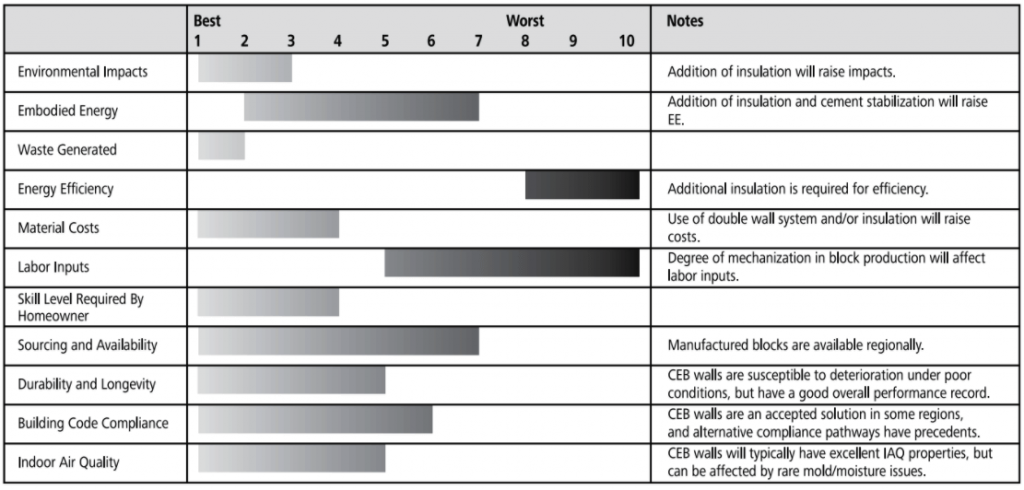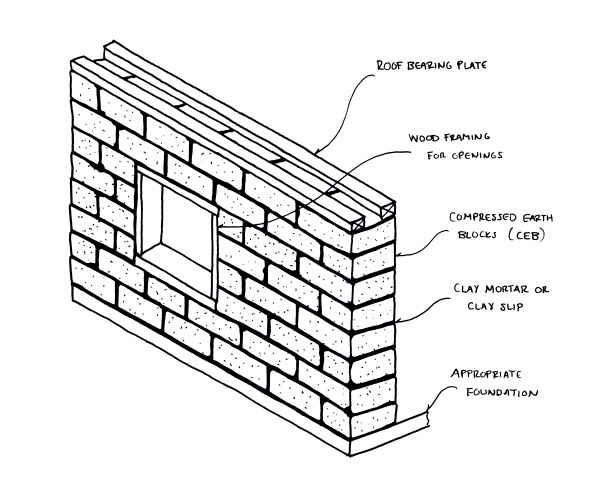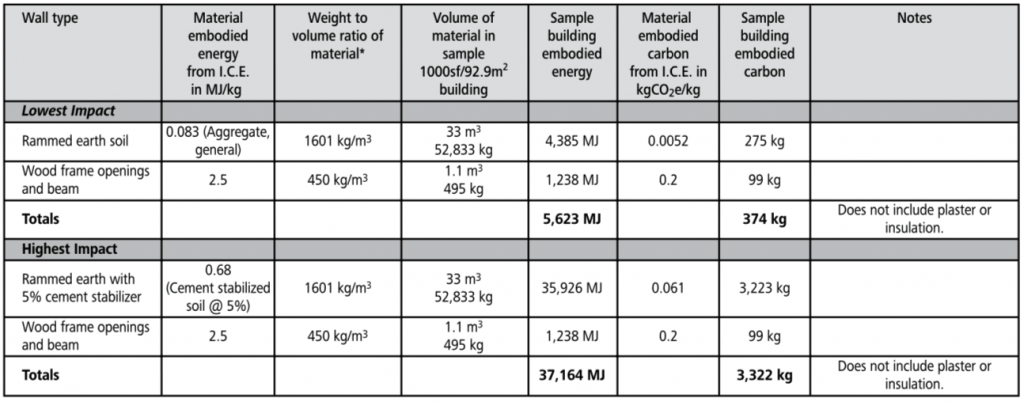Compressed earth block
Walls: MATERIALS ENCYcLOPEDIA
Applications for this system
Load-bearing exterior walls
Infill walls
Interior walls
Decorative interior elements
Basic materials
Earth
Stabilizer (cement or lime where required)
Mortar or slip
Insulation (where required)
Water-resistant finish (where required)
Control layers:
Water — The finished earth block is typically the water control layer. It is possible to use vapor-permeable, water-resistant finishes on the rammed earth surface or to include water-resistant additives in the earth mix before ramming. It is also possible to use additional cladding over the blocks, but this is rarely done.
Air and vapor — Solid and dense, CEB is an effective air and vapor control layer when laid in continuous, gap-free mortar or slip beds.
Thermal — A CEB wall requires an additional thermal control layer in hot or cold climates (see Thermal Mass vs. Insulation sidebar). This layer can be on the interior, exterior or center of the wall.
Ratings Chart for compressed earth block wall

The ratings chart shows comparative performance in each criteria category. Click on the tabs below for detailed analysis of each criteria.
- HOW THE SYSTEM WORKS
- ENVIRONMENTAL IMPACTS
- WASTE
- EMBODIED CARBON
- ENERGY EFFICIENCY
- MATERIAL COSTS
- LABOUR INPUT
- SKILL LEVEL REQUIRED
- SOURCING & AVAILABILITY
- DURABILITY
- CODE COMPLIANCE
- INDOOR AIR QUALITY
- RESOURCES
- FUTURE DEVELOPMENT
Compressed Earth block System

Compressed earth blocks are masonry units made from rammed earth. As with monolithic rammed earth, a moist soil mix with relatively low clay content (10%–30% is common) is rammed into block forms under high pressure to achieve a desired level of compaction. The soil mix varies by region and builder, but it is common to “stabilize” the mix with 5%–10% of portland cement or other hydraulic binder.
Block presses can be simple machines that use leverage and human effort or purpose-made hydraulic presses that include soil-mixing capability. Blocks are typically given time to air dry/cure before being used in a wall.
Once pressed, CEBs are laid up in a running bond similar to other masonry units. Mortars can be clay based, rather than using more conventional lime or cement mixes. Conventional mortaring techniques are common with joints ranging from ¼”–¾” (6–20 mm). Some builders elect to brush on a thick clay slip rather than lay an actual mortar bed. Blocks are set onto the wet slip and slid into place.
All the conventions of block and bricklaying apply to building with CEBs. Window and door openings use wooden, concrete or steel lintels. At the top of the wall, a wooden, concrete or steel beam system is used to provide rigidity and a fastening point for the roof.
CEB walls require insulation in most climates. This can be applied on the interior or exterior wall, or a double wythe system can be insulated in the core.
Environmental Impact Rating
Harvesting — Negligible to Low
Site soils will have negligible impacts. Regionally sourced soil will have minimal impacts from the machinery used for excavation and handling.
If hydraulic binders are used, they are mechanically extracted from quarries and can have low to high impacts on habitat and ground and surface water contamination and flow.
Manufacturing — Negligible to Low
Human-powered presses will have negligible impacts. Hydraulic presses will have impacts from the fossil fuel use of the machinery.
Hydraulic binders like lime and portland cement are fired at extremely high temperatures and have high impacts including fossil fuel use, air and water pollution and greenhouse gas emissions.
Transportation — Negligible to High
Sample building uses 52,833 kg of rammed earth:
49.7 MJ per km by 35 ton truck
Many CEB manufacturers bring equipment to a site and use native soil, resulting in negligible impacts. Blocks are a heavy and high-volume material and accrue impacts proportional to distance traveled. CEB tends to be used regionally, with little long distance shipping.
Installation — Negligible
Waste: Low
Biodegradable/Compostable — Unmodified soil ingredients, block offcuts, natural insulation materials.
Landfill — Cement bags, manufactured insulation offcuts.
Chart of Embodied energy & carbon
Energy Efficiency: Low to moderate
An earth block wall has a lot of thermal mass and can easily be an airtight wall system, but it has no inherent insulation value (see Thermal Mass vs. Insulation sidebar). The overall energy efficiency of a CEB wall system will be dependent on the insulation strategy. Insulation can be placed on either the interior or exterior of the wall or a double wythe system can have insulation in the center of the wall.
Insulation on either side of the wall will force a builder to create a finished surface over the insulation, which adds cost and complexity to the wall system and isolates all of the available thermal mass on one side or the other. Core insulation is more effective and leaves the blocks exposed as the finish on both sides. Unlike rammed earth walls, core insulation can be added after the walls are built, leaving many more options for the builder, including loose-fill insulation types poured between the wythes.
Material costs: Low to moderate
The basic soil mixture for blocks may be found on site or close to the building site for no or little cost. Pre-manufactured blocks can range widely in price depending on the economies of scale, with costs ranging from $1-4 per block regionally.
Labour Input: moderate to High
There are two distinct labor phases in CEB construction. Making the blocks requires excavation, movement, mixing and compressing of soil. The more mechanization in this process, the less labor required. It is also possible to purchase ready-made blocks from a supplier in some regions, which eliminates this portion of the labor from the on-site inputs of the builder. For builders who don’t want to learn about soil mixes and block making but wish to use rammed earth material, CEBs make rammed earth available as a product.
Laying up CEBs requires the same labor input as any masonry unit construction.
Skill level required for homeowners: moderate
The operation of a low-tech, manual earth block press can be learned quickly. Experimentation and research can help a novice arrive at an appropriate soil mixture.
Purpose-made block pressing machines are expensive and complicated, and this type of production is usually left to professional producers.
The laying of CEBs requires the same skill sets required for any masonry unit construction. A newcomer can learn to lay blocks, and many avenues for such training exist and would be recommended prior to tackling an entire wall system. Working with clay mortar is more forgiving than with hydraulic mortars, as working times are greatly extended.
Sourcing & availability: Easy to Difficult
Soils suitable for making earth blocks are widely available, as are the ingredients needed to amend less ideal soils.
A manual block press can be built using very basic and widely available materials. Hydraulic block presses are made by only a few companies and will need to be imported to most regions.
CEB producers are common in some regions and much less so in others. Blocks are not likely to be sold at conventional building supply stores, even in areas where they are commercially produced. Research will need to be done to locate suppliers.
Durability: moderate to High
Though compressed earth blocks do not have quite the same long history as rammed earth walls, the basic material is the same and will have very similar properties. CEBs are susceptible to degradation from wetting and freeze-thaw cycles. Blocks with stabilizers may be less vulnerable. Permeable paints and coatings can improve water resistance, as can plasters and other protective siding options. Adequate roof overhangs and proper site drainage can limit the amount of exposure to precipitation, helping durability.
Earth blocks are quite easy to repair, as new earth mix can be plastered over weathered blocks to restore appearance.
Code compliance
Commercially produced CEBs have consistent strength properties that suit codification. In some regions, CEBs are an accepted solution, and where this is not the case there are a wide range of test documents that can simplify alternative compliance applications. Because masonry unit construction is familiar and code-recognized in all jurisdictions, building officials are likely to understand the principles of the system and therefore be receptive to its use. A structural engineer’s approval may be required to validate test results and apply them to a particular design.
Indoor air quality: moderate to high
Uncontaminated earth is generally agreed to have no inherently dangerous elements and is consistent with the aims of high indoor air quality.
Soil contamination, from natural sources like radon or synthetic sources like petrochemicals, is possible, and it is wise to inspect and/or test soils before using them to build a house.
Resources for further research
Galer, Titane, Hubert Guillaud, Thierry Joffroy, Claire Norton, and Oscar Salaza. Compressed Earth Blocks: A Publication of Deutsches Zentrum Für Entwicklungstechnologien — GATE, a Division of the Deutsche Gesellschaft Für Technische Zusammenarbeit (GTZ) GmbH in Coordination with the Building Advisory Service and Information Network — BASIN. Braunschweig, Germany: Vieweg, 1995. Print.
Rael, Ronald. Earth Architecture. New York: Princeton Architectural Press, 2009. Print.
Morton, Tom. Earth Masonry: Design and Construction Guidelines. Bracknell, UK: IHS BRE, 2008. Print.
Jaquin, Paul, and Charles Augarde. Earth Building: History, Science and Conservation. Bracknell, UK: IHS BRE, 2012. Print.
Keefe, Laurence. Earth Building: Methods and Materials, Repair and Conservation. London: Taylor & Francis, 2005. Print.
Future development
CEB construction lends itself well to more widespread acceptance and use. The building process and appearance of bricks and concrete blocks is familiar, and the switch to a raw earth version takes less adaptation than other alternatives. Block presses are well-developed machines with a proven history and lend themselves to mass production of blocks. Most regions have a large enough pool of masons capable of building CEB walls to meet growing demand. Codification of CEB construction is made simpler by the manufacturing process, which can eliminate many of the variables that make other natural building systems hard to regulate.
Tips for a successful CEB Wall
1. Soils used for CEBs must be very well mixed. Even distribution of clay and any additional binders (cement, slag, lime, fly ash) is crucial to final wall strength. With most other earthen building systems, the mix is made very wet, which aids in thorough mixing. But CEB mixes do not benefit from the plasticity that water adds, and require plenty of mechanical mixing to achieve best results instead.
2. Test potential soils well before using. The makeup of the soil is critical to the performance of the wall. A lot of soil is required to make a CEB wall, and changes in its composition will mean that mixes must change too. Make sample blocks and use reliable sources to determine whether or not you will need stabilizers, and which ones are most appropriate for the soil type.
3. Consistent sizing of blocks is important if they are going to be attached using slip instead of mortar. The slip doesn’t provide enough thickness to make up differences in heights between inconsistent blocks. If blocks are not the same heights, using a mortar joint will help prevent stress points and cracking.
4. Following the conventions of brick/block laying will provide the best results. Though the material in earth blocks is unique, the proper techniques for building are common to all masonry units.




